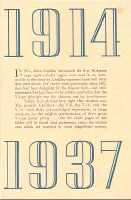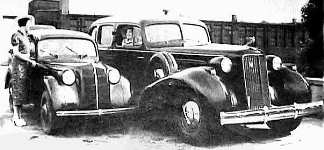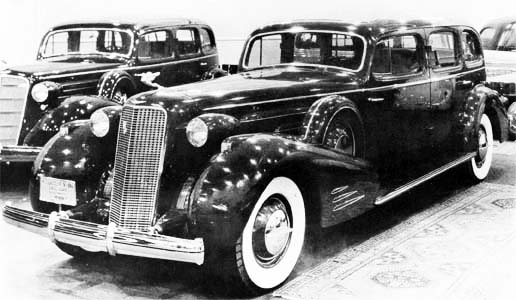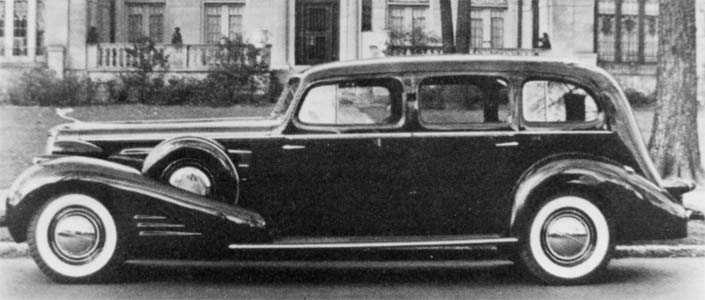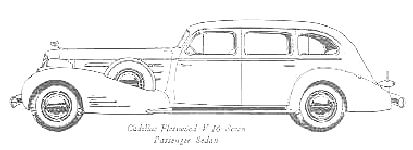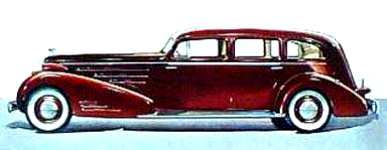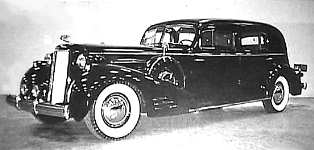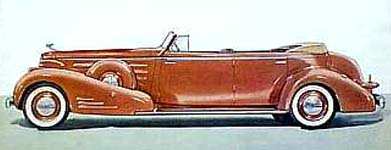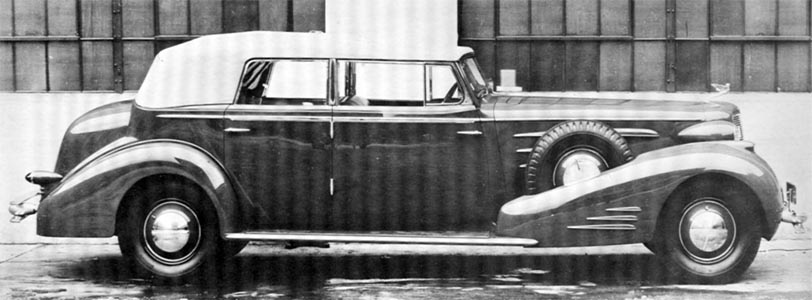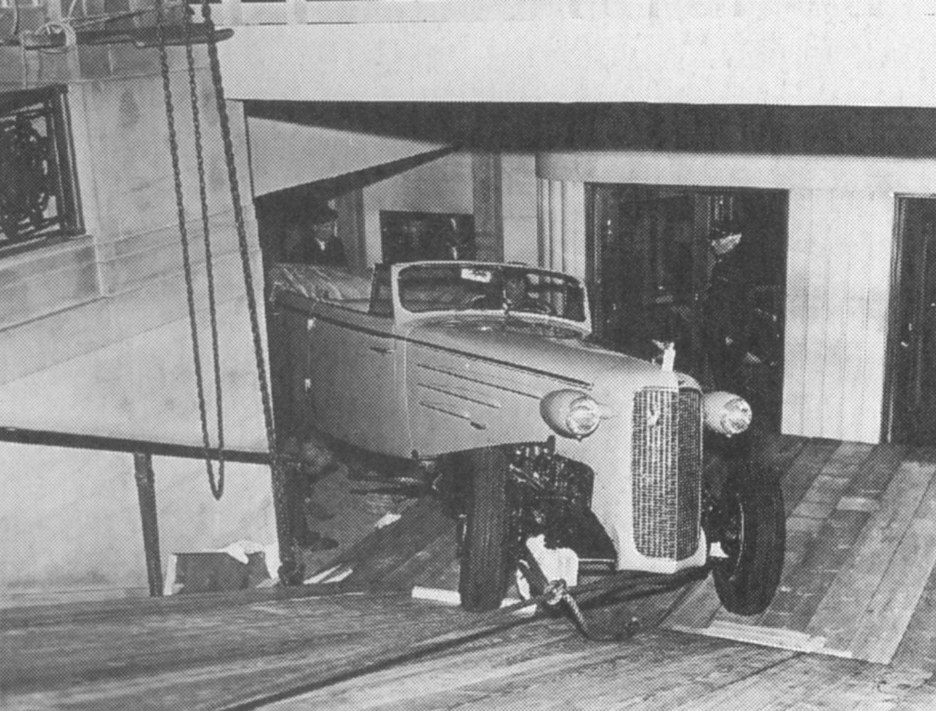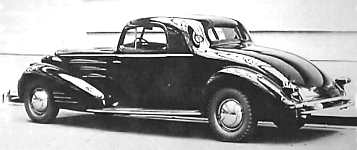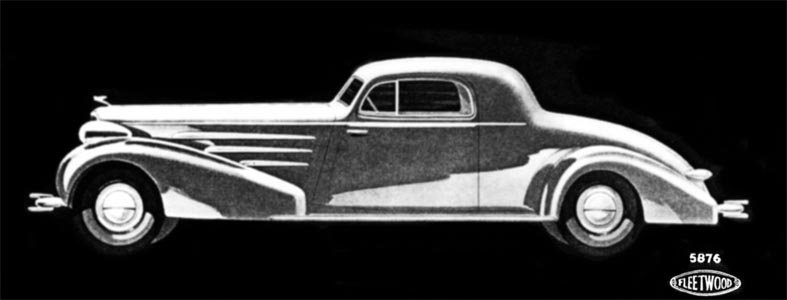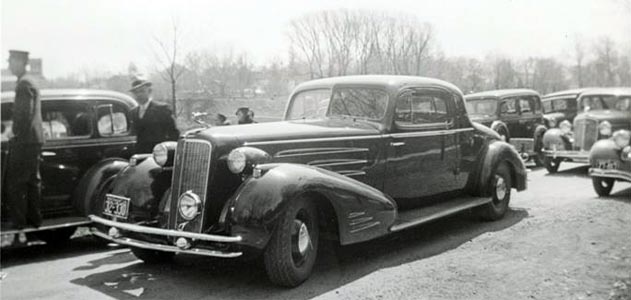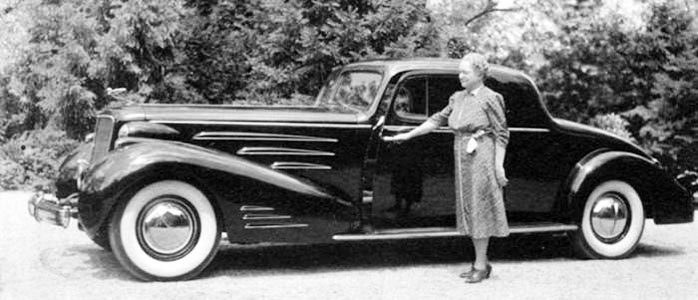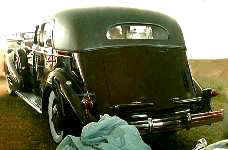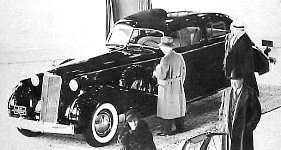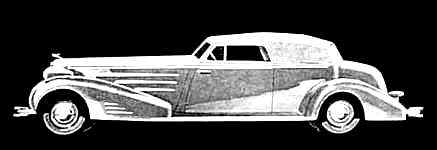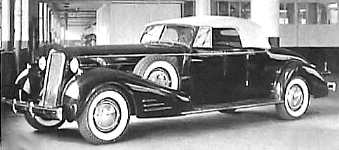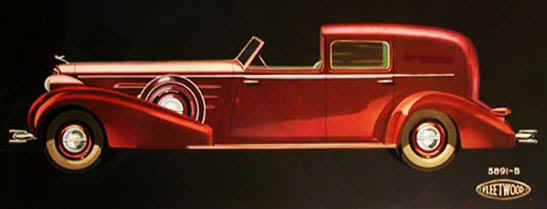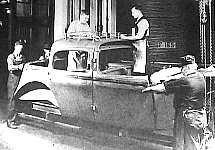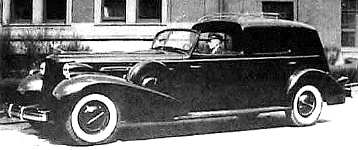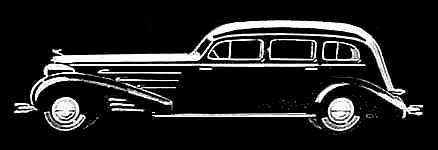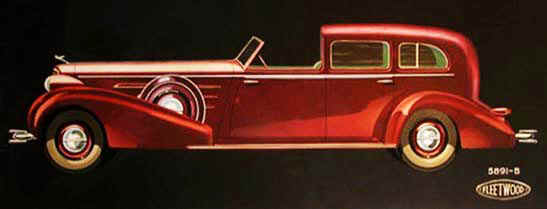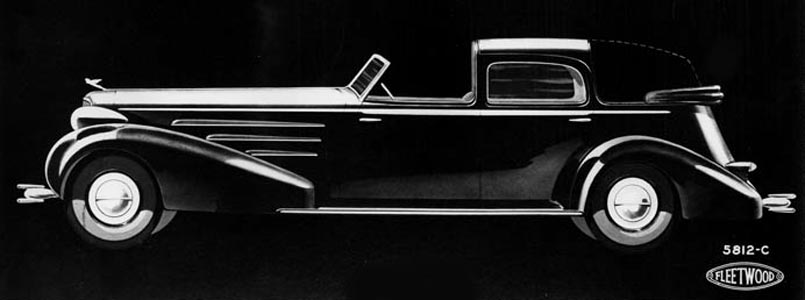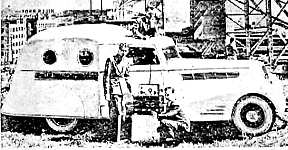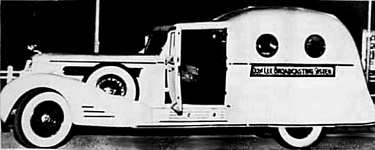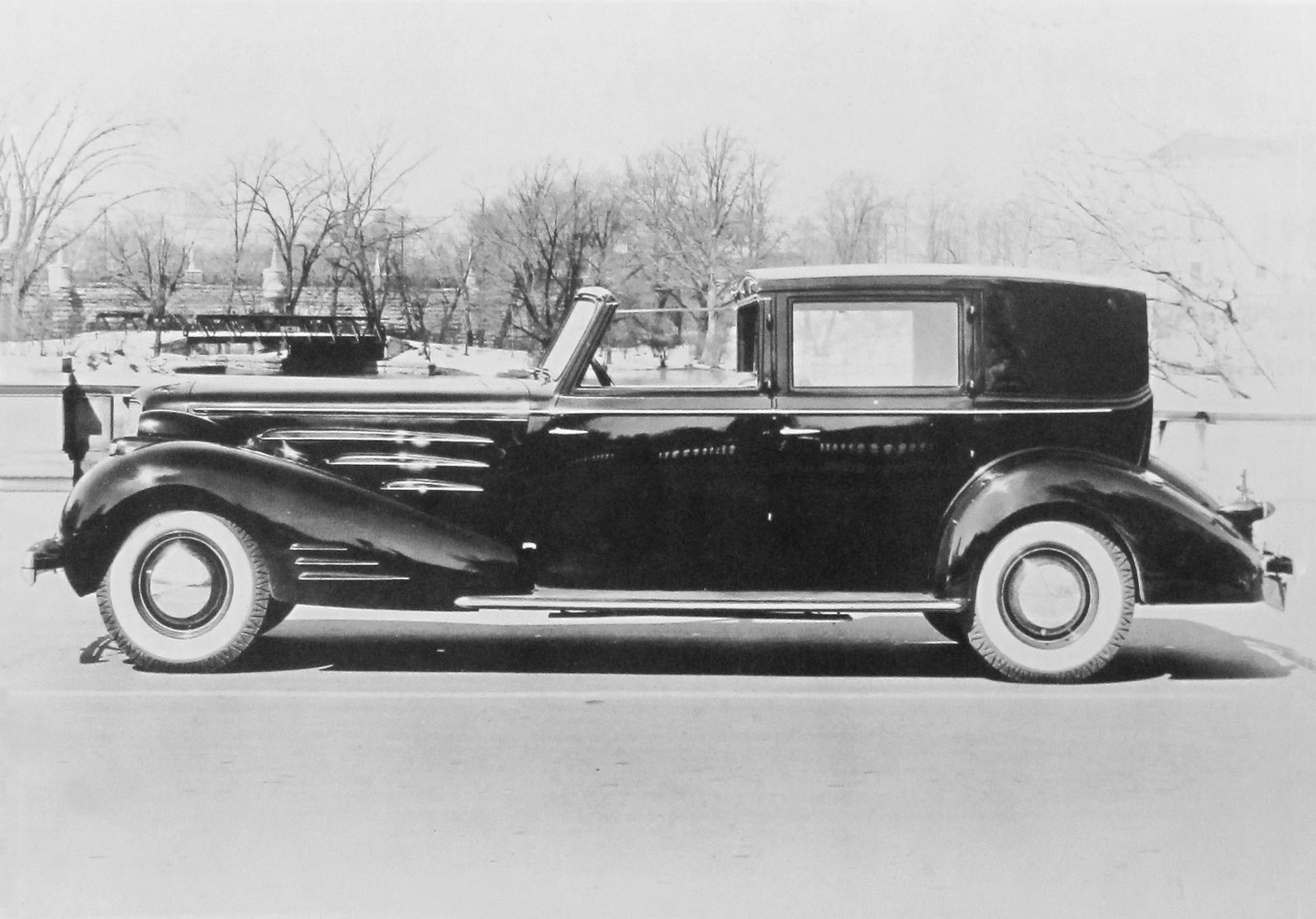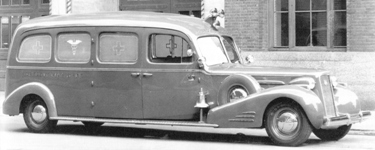Vee-sixteen styling remained
basically unchanged throughout the four-year period from 1934 to 1937. The only noticeable
difference was in the 1934 cars; these were fitted with twin-bar or bi-plane bumpers
superimposed on two "bullet"-type stanchions. These bumpers were less sturdy
than the later kind and many owners of a 1934 V16 subsequently had the bi-plane bumpers
replaced by the new, flat, single-bar type of 1935-1937. Not only did that improve
the effectiveness of the bumpers but also it was a cheap way to "upgrade" the
car by one, two or even three years!
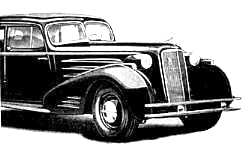 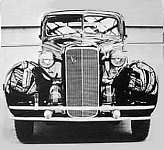
Tall, slender grille and continuation of matching
hood and fender spears
This is the 1934 style with the bi-plane bumpers
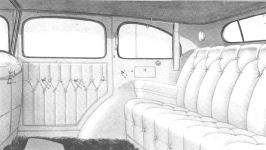
Interior trim, proposal from
Book(s) of Fleetwood for 1934 and 1935

|
Following the success of the
aerodynamic show car built for the World's Fair, Chicago, 1934, there was a new trend to
conceal the spare tire in the trunk of the automobile. The popularity of
side-mounted spare wheels was waning, although these could still be ordered optionally.
Two different tire storage options were offered, depending on the body style selected:
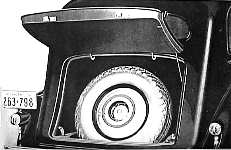 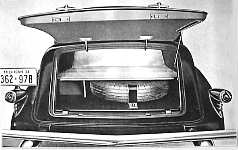
Left: trunk storage for single spare in the larger
sedan styles
Right: different layout in convertible styles and town sedans
|
Three pages of the 71-page book of
Fleetwood styles for 1934 list special features as well as optional equipment and
accessories. Space constraints prohibit my listing all of them here; however,
I shall gladly send you copies of these 3 pages if you are interested and will kindly send
me a SSAE [you may find my mailing address in the "Introduction" section of the
Database].
Items could be added or even deleted
[no credit]; these included hardware cases, wood paneling, adjustable seating,
special pockets, hassocks, foot rails, rubber mats, grip handles, curtains, sheepskin
rugs, clocks, parcel hammocks, pillows, arm rests, dome lights, robes, auxiliary seats,
quarter windows, leather roof coverings. Another popular accessory was the
Fleetwood, swing-out luggage rack. It is shown below in the closed and open
positions:
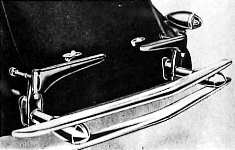 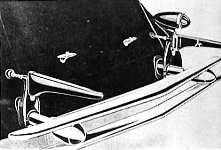
Fold-out trunk rack
|
Technical innovations in 1934
(all-models) included the new, so-called "knee-action" front suspension which is
illustrated below for those of you who understand the marvels of machines and mechanisms.
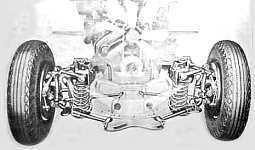
Knee-Action front suspension
|
Fisher bodies were not offered or
built on the V16 chassis from 1934-1937. Also, there was a single wheel base
for the V16 chassis this year; it stood at a massive 154". On this chassis were
built the longest, stock, passenger-cars in the world, with the exception - perhaps
- of Ettore Bugatti's "Royale" models; but then only a half dozen of the
latter were ever built.
Trivia: The
horn button on these cars carried a three-digit Feetwood ID number as well as the name of
the original purchaser. The number corresponded with the last three digits of the VIN
(engine/chassis number). Assuming that one did find such a horn button (sans
car) one could eadily identify the body style and number of the original car.
Factory records - build sheets - are listed in numerical order of the VIN.
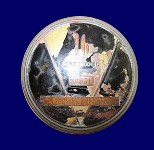 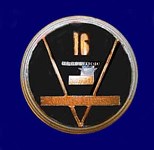 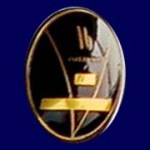
The one on the left came up for sale on EBay in
April, 2009; the number
appears to be "336" and the name appears to end in "...CAAN";
the center image is my own PhotoShop "reconstruction" of the damaged
button;
the image on the right is of the horn button of a rare, surviving car (#313)
|
Click here
to see a (non-exhaustive) list of survivors and to view some more photos.
The table below summarizes
vee-sixteen production for the four model years from 1934 through 1937. The bodies
were the same, in fact, for all four years.
1
On the actual cars, the style number begin with initial digits "57"
instead of "58".
2 Prices shown in the
"Notes" column are from the 1937 price list dated October 20, 1936 (that was
kindly supplied to me by Dennis Derion); they include a new, $250-$300 destination
charge. In 1935, prices went down $200 from 1934. in 1936 prices
diminished again from $150-to $200, depending on the model.
3 According to Stan Squires,
owner and admirer of these sixteens, the bare chassis released in 1936 had numbers
5110234, 5110242 and 5110246; two bare chassis were exported in 1937, viz. #5130328
(which went to Switzerland) and #51030348; he mentions another
1937 chassis (#5130316) for which the factory build sheet was lost (BTW, the cost of a
bare V16 chassis/engine combination in 1937 was $6250
4 Of the seven bare V16 chassis
released by the factory between 1934 and 1937, at least two went to Brunn of
New York (one from 1935 and one from 1936). Of the five remaining, two were exported
(one to Canada - year not known - and one to Switzerland in 1937); there appears to
be no records of the destination of the three remaining chassis.
Some
factory and catalog photos
most drawings are from the 1934 book of Fleetwood designs
[from 1935 to 1937 the cars had the new, flat, single bar bumper]
According to
automobile designer and historian, Alex Tremulis, tbe artist's renderings of proposed body
styles that appear in the Book of Fleetwood for 1934 and 1936, were the work of a
talented Canadian designer called John Hampshire who worked in Cadillac's "Art &
Color" section under the great Tom Hibbard.
Nota: The actual artist's renderings in the 1934 Fleetwood catalog do not show
the three fender moldings ("spears") that are typical of all sixteens built from
1933 through 1940. I have added them to each drawing for greater realism.
Style
#5875 (5775)
![]()
